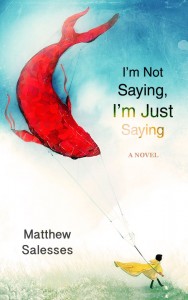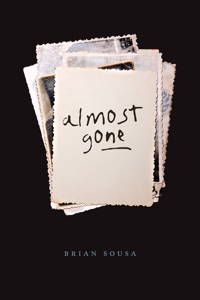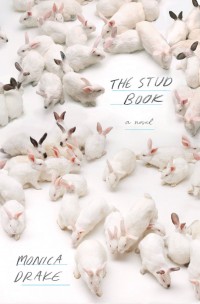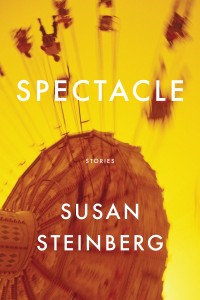I’m Not Saying, I’m Just Saying
 I’m Not Saying, I’m Just Saying
I’m Not Saying, I’m Just Saying
by Matthew Salesses
Civil Coping Mechanisms, February 2013
138 pages / $13.95 Buy from Amazon
Koi fish have hundreds of scales that form a protective armor around them. Matthew Salesses’s I’m Not Saying, I’m Just Saying is a collection of 115 flash fictions that, like those scales, explore the spoken and unspoken nuances that connect and glue relationships in all their misfit forms. Many of the characters go unnamed, a decision that suggests that the companions symbolize divergent desires. There’s the wifely woman who’s his main lover and there’s a “white woman” who acts as a mistress as well as another Korean woman who is in place “for emergencies.” Each serve a different need, though none can satisfy him because he partitions himself like the segmented chapters that comprise the book. They are lyrical segments akin to jazz solos forming a striking concerto of prose. The impetus that triggers the journey of the book is the appearance of a son he never knew he had. When the boy’s mother, an old lover, passes away, the narrator takes the son into his home. Rather than a definitive reaction to this revelation, there’s a miasma of conflicted emotion, an uncertainty that could best be summed up in the piece, “She Was a Tsunami to His Earthquake:”
His lovers, his co-workers, and finally, his son, form a tenuous thread that bind the invisible wavelengths of his life together. Only, he is always trying to split them apart and keep them isolated in a delicately stratified web. In describing the side girl-on-the-side, he says: “I had to be careful with her, though I wasn’t technically married, because she collected the crumbs of truth, but for an hour with her, I was someone else, and when I left, I could discard that part of me and know it would be repossessed.” The elegance of the book lies in the poetic congruence with which his life is shattered by circumstantial incongruence. Say, for example, his observation at an art gallery with his son that only the letter T separates the word “paint” from “pain.” This was an association formed from his failure to be the artist he aspired to be as a freshman in college. He is protecting himself from pain, but entering it willingly to try to teach his son something about painting. That contradiction of both being in the mural and trying to control it hints at the theme of a man all too aware of his foibles and flaws, but still is helpless to do anything about it. Twisted accents in his relationships add shades and make every interaction a layered strip tease, tantalizingly bare without showing anything essential:
May 17th, 2013 / 11:00 am
Almost Gone by Brian Sousa
 Almost Gone
Almost Gone
by Brian Sousa
Tagus Press at UMass Dartmouth, February 2013
192 pages / $19.95 Buy from Tagus Press or Amazon
Brian Sousa’s debut is a novel-in-stories about the life and tragedies of three generations of a Portuguese-American family living in Rhode Island. Their lives are punctuated with a series of desperate escapes abroad, beginning with Scott on the beaches of Brazil mourning the death of his young daughter, re-enacting her drowning in several senses of the word. He doesn’t know that it was a similar flight of desperation that brought his grandmother and grandfather to America from Lagos, Portugal many years ago.
The characters may occasionally run, but they cannot hide from their literary fate. Each character’s private pain explored in turn; each timely revelation increases the stakes. Helena emigrates from Lagos with her husband Nuno, and finds her life in America barren and cruel in comparison. Nuno cannot muster any grief for his wife’s death, and instead nurses his obsession with Catarina, the beautiful Portuguese woman who lives in the guest cottage behind his house. Nuno’s son Paulo listens to his teenage son Scott having sex, while his own marriage is rapidly deteriorating around him. Ten years later, Scott’s marriage is no better: he loses his child and abandons his wife. The unwitting observer to all of this family drama is Catarina, who can never seem to escape her fate as the object of every man’s desire. She too leaves her husband, fleeing into the streets of Granada.
These are stories of loss, infidelity, alienation…all the persistent demons of modern suburban life. And for that matter, of suburban literature since the dawn of Cheever. But Almost Gone glimmers when Sousa manages to step outside conventional grief, and twist the knife ever so slightly. The best example of this is a deeply awkward scene where Nuno arrives at the cottage to woo Catarina, after his son Paulo has just tried the same and left, rejected. Nuno falls, and pleads with her from the ground:
May 17th, 2013 / 11:00 am
Maybe if…
Maybe if Syrian people started being blown up while running marathons in Boston then the white race would care more about it…
Men in partial or full military dress went door to door, separating men — and boys 10 and older — from women and younger children.
Residents said some gunmen were from the National Defense Forces, the new framework for pro-government militias, mainly Alawites in the Baniyas area. They bludgeoned and shot men, shot or stabbed families to death and burned houses and bodies.
– “Grisly Killings in Syrian Towns Dim Hopes for Peace Talks,” Anne Barnard
… Although, according to Baby Adolf, if you want attention for being killed by the boatloads then you should probably be J E W I S H.
Speaking of that, Baby Idi is having a hard time comprehending that “Jewish, New York sense of humor.” Is there anyone out there that can elucidate it for him?
… Anywho, Baby Marie-Antoinette could really use a soft cherry cream cheese croissant right about now.
25 Points: The Stud Book
 The Stud Book
The Stud Book
by Monica Drake
Hogarth, 2013
336 pages / $25.00 buy from Amazon
1. Monica Drake has written a compelling novel of manners.
2. The Stud Book follows a group of adult friends in Portland, Oregon (aka everyone living in America today) as they reconcile expectations with reality.
3. There is a zookeeper, a mortgage underwriter, a photographer, a yogi, and a computer repairman. Unsurprisingly, hilarity ensues.
4. Drake diffuses the novel’s many anticlimaxes (mishaps, muddled careers, domestic failings, generally unrealized ambitions) with a singular sense of humor.
5. The Stud Book is a book about motherhood. And the baby jokes crackle. A woman mistakenly licks a bit of dirty diaper from her shirt (not mustard!); another knocks an Oxycodone into an infant’s mouth. Drake exploits babies like the vulnerable little props they are.
6. Drug humor abounds as the friends imbibe in the manner of well-established stoner citizens. Justifying a “Volcano” vaporizer at a high school assembly one says, “I’ve got a chronic pain problem. This is totally legal.” Another drives high, she “ignoring the dosing instructions… nibbled pills all day long.” “She’d started to see the benefit: a military dose of Klonopin with red wine, dished out like a free lunch, would end the troubles in the Gaza Strip.” “Her car was speckled with pink, pale yellow, and white pill crumbs, Klonopin, diazepam, Vicodin.”
7. But beyond bad behavior, Drake finds a gentle humor in frailty.
8. On justifying the purchase of a derelict storefront, “Crack addicts curled in the recessed doorway and cans of OE8 littered the curb, but there was a Starbucks practically next door. Starbucks with their market research was an indicator the neighborhood was poised for an upswing.”
9. On Mrs. Cherryholmes, the beautiful but villainous school principal, “Her lipstick was frosted, too, in a sheen of confidence. That was probably the actual lipstick color: Administrative Confidence.”
10. One particularly funny and gruesome scene of self-love is a shoo-in for the annual bad sex in writing award, “He spit on his hand, cupped it and rubbed his damp palm over the head of the cock.” READ MORE >
May 14th, 2013 / 5:35 pm
Summer Semester Reading List: Conceptual Literature

This week I begin teaching a six week summer course on conceptual literature. For those of you who might be interested, click through for the reading list I’ve assigned my students.
A bit more on Susan Sontag and “Against Interpretation”
I’m still bogged down with school (almost done) but I thought I’d throw a little something up, pun intended. Two months ago I wrote an analysis of Susan Sontag’s “Against Interpretation” where I argued that, rather than being opposed to all interpretation, as some believe, Sontag was instead opposed to “metaphorical interpretation”—to critics who interpret artworks metaphorically or allegorically. (“When the artist did X, she really meant Y.”) I thought I’d document a few recent examples of this—not to pick on any particular critics, mind you, but rather to foster some discussion of what this criticism looks like and why critics do it (because critics seem to love doing it).
The first example comes from Chicago’s Museum of Contemporary Art, in particular the exhibit “Destroy the Picture: Painting the Void, 1949–1962” (which is up until 2 June). One of the works on display is Gérard Deschamps’s Tôle irisée de réacteur d’avion (pictured above, image taken from here—I didn’t just stretch out a swath of tinfoil on my apartment floor). The placard next to it reads as follows:
Red Doc> by Anne Carson
 Red Doc>
Red Doc>
by Anne Carson
Knopf, March 2013
192 pages / $24.95 Buy from Amazon or IndieBound
As a semblance of promotion for her new book, Anne Carson wrote: “Recently I began to wonder what happened to them in later life. Red Doc> continues their adventures in a very different style and with changed names. To live past the end of your myth is a perilous thing.”
Carson made a surprising move releasing a sequel to 1998’s Autobiography of Red, a novel in verse about a boy with wings named Geryon and his love affair with Herakles.
Though sequels are better known in blockbuster films, the constellation of literature has its share of sequels, if not always in predictable forms.
Grace Paley uses her character Faith in multiple books as does Junot Diaz with his narrator, Yunior. Anthony Powell’s A Dance to the Music of Time, a twelve-novel cycle, delivers an interesting take on the sequel—a word whose etymological roots entail sequence, a body of followers, consequence, descendants.
What a formulaic generic choice a sequel could seem for Carson, who considers herself an instructor and translator of Ancient Greek first, and a literary wunderkind (my word) second.
But doesn’t translating ancient works often involve a form of sequencing? There was nothing ancient about the Herakles (Hercules) myths when first recounted. To translate requires fidelity to the original language and intent, while sometimes taking license to contemporize and update the story.
In Red Doc>, Geryon is no longer a boy. He still likes photographs. He is still homosexual. He still has wings.
G, as he’s now called, is a military veteran. And whereas Geryon traveled to South America, G drives northward into an icy expanse with a fellow vet named Sad, a reconfigured Herakles.
Their car breaks down and they find themselves at the mouth of a cave. G’s wings are itching something fierce. “Stiffened/wing muscles pull hard/against their roots and/move into a lift,” Carson writes of her protagonist.
May 13th, 2013 / 11:00 am
Luke Goebel interviews Susan Steinberg
 Susan Steinberg’s new fiction collection, SPECTACLE (Graywolf), is a series of linked and formally-inventive short stories told by female narrators who are dealing with catastrophic as well as domestic tragedies.
Susan Steinberg’s new fiction collection, SPECTACLE (Graywolf), is a series of linked and formally-inventive short stories told by female narrators who are dealing with catastrophic as well as domestic tragedies.
The narrators of a seemingly singular history convey the stories, but are not (Steinberg says) the same narrator—or at least they weren’t written, if I understand Steinberg, as a continuous narrator. So, in this book the same events in two stories can be changed depending on which unnamed narrator—of roughly the same age, build, hair color, and city of origin as Steinberg—is narrating the SPECTACLE. This structure creates a narrative that overlaps, readdresses, carries over pain and learned approaches, and anxiety—the consummate whole getting higher in fever pitch until disaster and ultimately catharsis are reached.
SPECTACLE is an apt title—because the events of the world, the spectacles, and conflicts make narrators who are strong and clever and aware, unable to escape the pressures that build around them and at times the pressures that fall from above. Steinberg’s narrators are powerful, seductive, wounded, and aware of their roles, their performance of gender, identity, and “self.” They are tough.
SPECTACLE has been praised by the New Yorker, nominated for the year’s O’Connor Prize, and reviewed at Bookslut, Publishers Weekly (starred review), SF Chronicle, and at no shortage of other places where “experimental fiction” is most often passed over, proscribed, verboten!
Why is this book getting unvarying attention? Of course it is many things, none so much I might suggest as important as voice—replete with sex, confession, revelation, and genuine risk.
While Steinberg is not telling the factual truth in these stories, she is doing something crafted with such risqué confession that readers take her stories as factual (I admit I did. Even though I knew “better.” Even though she was my first writing teacher and taught me that fiction is fiction). Readers conflate Steinberg with her narrator(s)—and reading this book you see instantly that this is a position of danger for any writer. Because maybe you can’t make this crazy up. Because there’s risk in really talking about one’s gender. Because it isn’t crazy; it’s genius. It’s truth. These speakers are so solipsistic they lose identity, become universal in their extreme isolation and anxiety—they retain awareness and becoming weaponized in awareness of gender.
This collection can be read as an experimental novel composed of many fictions forming an aggregate and rupturing whole. Here is one you cannot look away from, which implicates the minds and bodies of the readers, which reveals what has remained taboo far too long. These stories are not political, not ideological—they are honest in such a way as to make them threatening and unnerving and difficult to talk about.
LBG: Do you mind if we start with something simple, from right off the cover of your book?
S.M.S: I don’t mind.
LBG: Okay. On the back of the book is this synopsis: “SPECTACLE bears witness to alarming and strange incidents: carnival rides and plane crashes, affairs…and amateur porn, vandalism and petty theft. In these stories, wounded women stand at the edge of disaster and risk it all to speak their sharpest secrets.”
LGB: Is this how you see the book? Is that what the book bears witness to—to strange incidents and wounded women at the edge of disaster? Speaking their sharpest secrets?
S.M.S: The book does contain these specific things: affairs, amateur porn, vandalism, planes crashes, and theft. The book also contains the abstractions you mention: secrets and disaster. But had I written the copy, it likely would have mentioned more technical aspects of the book: semi-colons, fragments, one-sentence paragraphs. I tend to think more about the “how” than the “what” when asked what my work is about. But it’s the back of a book. I think readers want the what.
But I don’t think the incidents I write are strange. Do you?






